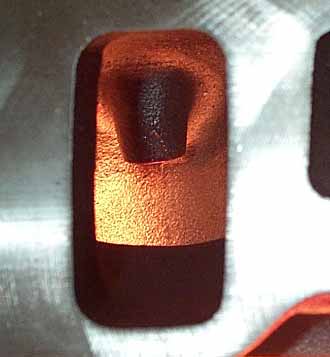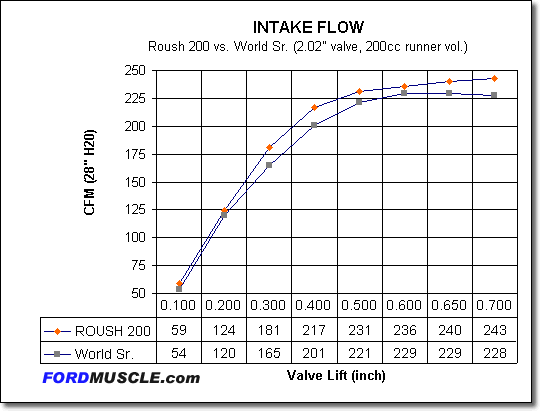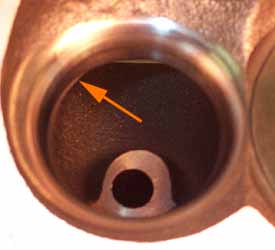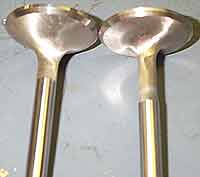Gromm
Racing Heads flowed the head on a Superflow 600 flowbench, the industry
standard.
The head was tested at a standard pressure of 28-in. of H20. To simulate
actual transitions, the intake side was fitted with a clay lip, however
no extension was used on the exhaust port.
A 4.030" cylinder was attached to the combustion chamber to simulate
the bore. The end chamber was tested on each head.
Both the intake and exhaust side were flowed in .100" lift increments,
to at least .600", or until max flow was reached. |
|
 TAKE
A DEEP BREATH! TAKE
A DEEP BREATH!
The
intake side of the new ROUSH 200 head shows a marked improvement
over its older brother, the World Sr.
Gromm pointed out to us that it appears World has made some changes
to the short side radius on the new heads -specifically the radius
is shorter and steeper. This typically will increase high-lift flow,
but could hurt low end flow. However World has balanced this with
other modifications to the intake runner.
The resulted is a 5-7% improvement in mid-lift flow compared to
the World. Sr. head.
Gromm did indicate that the valve guide bosses still have too much
material around them. Removing the excess material and reshaping
the guide-boss would show some reduce turbulence and improve flow.
Furthermore notice how the new head never trails off in flow, even
at 0.700" lift, where the Sr. is starting to decline.
|
|
 It
is tempting to look at these flow numbers and compare them directly
to those of the leading aftermarket aluminum heads. However this
is not a fair comparison considering ALL aluminum heads have some
degree of CNC port work as part of the manufacturing process. This
is part of what contributed to the higher cost of aluminum heads. It
is tempting to look at these flow numbers and compare them directly
to those of the leading aftermarket aluminum heads. However this
is not a fair comparison considering ALL aluminum heads have some
degree of CNC port work as part of the manufacturing process. This
is part of what contributed to the higher cost of aluminum heads.
On
the other hand, cast iron heads have very rough surface finishes
and some casting ridges to contend with.
Gromm indicated that a simple cleanup job with a Dremel and sanding
rolls would yield 8-10% increase in flow over the out-of-the-box
numbers. Now you've got some numbers to compare against TFS, AFR
and the like -and you are still saving hundreds of dollars.
|
 EXHAUSTED! EXHAUSTED!
The exhaust side of the World/ROUSH 200 heads is where we did a major
double-take. The port simply stopped flowing beyond 137 cfm at 0.400"
valve lift.
Initially we thought there was a problem with the flow bench, so Bob
Gromm checked to ensure everything was operating correctly and flowed
the exhaust port again. No change.
As the chart shows, the head simply shuts down at actually 0.300".
At 0.500" we calculated the percent exhaust to intake flow is
a wheezing 59.75% Ideally an exhaust port should flow 70-80% of the
intake flow.
|
 |
| The
poor exhaust flow is most likely due to this serious misalignment
between the valve seat and the exhaust bowl. We noticed this
on all the ports, and two sets of ROUSH 200 heads -indicating
a problem with the mold for these heads. |
Conclusion
Needless to say there is a major problem with the exhaust side of
the new ROUSH 200 head. Interestingly, one of the first things we
noticed, days before we had the heads flow tested, was a 1/16"
ridge where the exhaust valve seat meets the bowl. The ridge extends
about 180° around the short side radius of the bowl.
Our initial thoughts were that perhaps this was a problem with just
one port. However Gromm happened to have a couple sets of bare ROUSH
200 heads at his shop, and they too displayed the same problem.
Gromm suspects that the problem is due to "core shift",
a problem where the original mold for the head shifts off center,
subsequently affecting all the heads cast from that mold. The valve
seat is pressed in to the original design specifications, resulting
in a mismatch between the seat and head. This little ridge, especially
on the short side radius, can disrupt flow to the point that the turbulent
gas effectively blocks the port.
We reported our results to World Castings, and they confirmed that
they were working on fixing the core shift problem. We recommend that
you hold off on these heads until World has the problem resolved.
We do think that this is a head which shows tremendous potential for
the budget minded racer who is willing to put in a little effort.
As we mentioned, a few hours behind a Dremel tool or die-grinder and
you'll have a head in the 250 cfm range, but more importantly it will
maintain that level beyond 0.600" lift if you plan to run a monster
cam. |
 |
| The
budget Manley "Street-Flo" valve on the right is found
in just about all aftermarket Ford heads. Buying the heads bare
and stepping up to the "Race Master" valve (left)
improves flow and reduces turbulence. |
Valves
and things
One of the many interesting facts Gromm pointed out to us during our
visit to his shop was the importance of valves and their effect on
flow. We've known for some time, and Gromm confirmed, that ALL aftermarket
head manufacturers use budget valve train components to keep costs
down. Typically the springs are setup for a stock or mild flat-tappet
camshaft, and as we saw with the Edelbrock
heads, inferior shims may be used.
World has taken a step in the right direction by offering the ROUSH
200 with three levels of springs -depending on the type of cam (roller
versus flat tappet) and the amount of lift. (Check their website or
catalog for springs specifications.)
The other area companies notoriously cut costs is in the valves. The
most common valve used in the industry is the Manley Street Flo (right
one in our photo.) The valve boasts undercut stems and a swirl polish.
However Gromm pointed out that the angle of the valve head and the
thickness, or "margin", of the face has a huge effect on
flow. The thinner margin valves are typically installed by manufacturers
to avoid customer complaints of piston to valve problems. However
the thicker margin valve actually reduces turbulence and results in
the gasses getting past the valve faster - due to better convergent/divergent
gas flow, a physical process whereby gasses (and liquids) form into
two conical shapes, like sand in an hourglass, as the pass through
the valve. The thinnner valve margin results in disruption and turbulence
of the gas, breaking up the conical flow.
Gromm installed the Manley Race Master valve (left) in one of the
exhaust ports and re-flowed our head. There was an immediate gain
of as much as 5 cfm at mid-lift. If you recall, in our Heavy
Breathing article, Total Engine Airflow also changed the intake
valve when they ported our World. Jr heads and saw a whopping 23cfm
gain at 0.200"!
Gromms recommendation -always buy heads bare and have a professional
shop set them up with better valves and springs to match your specific
cam. You spend a couple hundred dollars more, but end up with considerable
gains in power and reliability. |
 |
| Like
many performance cylinder head shops, Gromm Racing Heads offers
a range of porting options. They have this Chevy head on display
which shows the four stages of port work. At about $285 the
Economy Pocket Porting would get the Roush 200 intake side above
270cfm range above half-inch lift. |
|
Sources:
World Castings
35330 Stanley
Sterling Heights, MI 48312
810-939-9628
Gromm Racing Heads
664 Stockton Ave. #J
San Jose, CA 95126
(408) 287-1301
|
|
|
|

